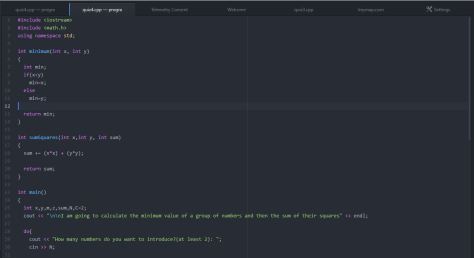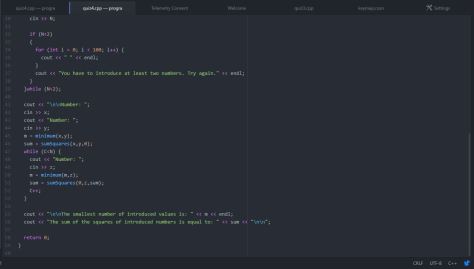The quiz for today consited in five exercises that we had to do during the class, which came from a page called C/C++ PROGRAMMING EXERCISES (they were the first five ones).
In the first problem, we had to modify a determinated code to make it work. The original code was:
#include
main()
{ /* PROGRAM TO PRINT OUT SPACE RESERVED FOR VARIABLES */
char c;
short s;
int i;
unsigned int ui;
unsigned long int ul;
float f;
double d;
long double ld;
cout << endl
<< "The storage space for each variable type is:"
<< endl;
cout << endl << "char: \t\t\t%d bits",sizeof(c)*8; // \t means tab
cout << endl << "short: \t\t\t%d bits",sizeof(s)*8;
cout << endl << "int: \t\t\t%d bits",sizeof(i)*8;
cout << endl << "unsigned int: \t\t%d bits",sizeof(ui)*8;
cout << endl << "unsigned long int: \t%d bits",sizeof(ul)*8;
cout << endl << "float: \t\t\t%d bits",sizeof(f)*8;
cout << endl << "double: \t\t%d bits",sizeof(d)*8;
cout << endl << "long double: \t\t%d bits",sizeof(ld)*8;
I opted for changing cout for printf, adding the stdio.h and iostrem libraries, as well as the line using namespace std; and declaring main as int. I consulted the page that our professor recommended to learn more about printf. It should be mentioned that what this program does is showing the number of bits that a type of value can store. My final code is the following one:
#include <stdio.h>
#include <iostream>
using namespace std;
int main()
{ /* PROGRAM TO PRINT OUT SPACE RESERVED FOR VARIABLES */
char c;
short s;
int i;
unsigned int ui;
unsigned long int ul;
float f;
double d;
long double ld;
cout << endl
<< "The storage space for each variable type is:"
<< endl;
printf("char \t\t\t%d bits\n",int (sizeof(c)*8));
printf("short: \t\t\t%d bits\n",int (sizeof(s)*8));
printf("int: \t\t\t%d bits\n",int (sizeof(i)*8));
printf("unsigned int: \t\t%d bits\n",int (sizeof(ui)*8));
printf("unsigned long int: \t%d bits\n",int (sizeof(ul)*8));
printf("float: \t\t\t%d bits\n",int (sizeof(f)*8));
printf("double: \t\t%d bits\n",int (sizeof(d)*8));
printf("double: \t\t%d bits\n",int (sizeof(d)*8));
printf("long double: \t\t%d bits\n",int (sizeof(ld)*8));
}
The second exercise was about casting types of values to other one, and return taken values. I have to recognize that I didn’t know what to do at the first, but after meditating on it a little, I realized that it wasn’t difficult at all. I just had to use printf again and specify that I wanted to convert a variable to another type different to the one that it was declared at the first. The utilized types were char, int and float. The next code is the one that I made for this problem:
#include <iostream>
#include <stdio.h>
using namespace std;
int main(){
char C;
int I;
float F;
cout << "Input a single character, followed by : ";
cin.get(C);
cout << "Input an integer, followed by : ";
cin >> I;
cout << "Input a float, followed by : ";
cin >> F;
printf("The character %c when cast to an int gives value %d\n",C,int(C));
printf("The character %c when cast to a float gives value %f\n",C,float(C));
printf("The integer %d when cast to a char gives value %c\n",I,char(I));
printf("The integer %d when cast to a float gives value %f\n",I,float(I));
printf("The float %f when cast to a char gives value %c\n",F,int(F));
printf("The float %f when cast to an int gives value %d\n",F,int(F));
return 0;
}
The third exercise only required to print a given pattern. This was my code (you will notice that it is very short and simple):
#include <iostream>
using namespace std;
int main(){
cout << " C" << endl;
cout << " i I" << endl;
cout << " s s" << endl;
cout << " b b" << endl;
cout << " e e" << endl;
cout << " s s" << endl;
cout << "t s e b s i C i s b e s t" << endl;
return 0;
}
The next exercise is a little more complicated, because it’s about ordering three numbers in ascending order so I made three different functions (first, second and last term) and each one contained conditionals, so my program resulted a little long (relatively).
#include <iostream>
using namespace std;
int minor(int x, int y, int z)
{
int m;
if (x<=y && x<=z)
m=x;
else if (y<=x && y<=z)
m=y;
else if (z<=x && z<=y)
m=z;
return m;
}
int medium(int x, int y, int z)
{
int m;
if ((x>=y && x<=z) || (x>=z && x<=y))
m=x;
else if ((y>=x && y<=z) || (y>=z && y<=x))
m=y;
else if ((z>=x && z<=y) || (z>=y && z<=x))
m=z;
return m;
}
int maximum(int x, int y, int z)
{
int m;
if (x>=y && x>=z)
m=x;
else if (y>=x && y>=z)
m=y;
else if (z>=x && z>=y)
m=z;
return m;
}
int main()
{
int a, b, c, P, S, T;
cout << "Number 1: ";
cin >> a;
cout << "Number 2: ";
cin >> b;
cout << "Number 3: ";
cin >> c;
P=minor(a,b,c);
S=medium(a,b,c);
T=maximum(a,b,c);
cout << "\n\nThose numbers, in ascending order, are: \n" << P << endl << S << endl << T << endl;
return 0;
}
Finally, the last problem I had to solve was this one:
“Given the following rules, write a program to read a year (4 digit integer) and tell whether the given year is/was a leap year.
- There were no leap years before 1752.
- If the year divides by 400 then it is a leap year.
- All other years that divide by 100 are not leap years.
- All other years that divide by four are leap years.
For example, 1800,1900 were not leap years but 2000 will be; 1904, 1908,…,1996 were/will be leap years.”
I had some problemas with my logic because I wanted to integrate all the “rules” at once, but I couldn’t do it since the program didn’t return the right values. Therefore I added some if’s, else if’s and nested conditionals to make it work. This was the result:
#include <iostream>
#include <string>
using namespace std;
string leap(int Y)
{
string R;
if (Y<1752)
R="That year was/will be NOT a leap year\n";
else if ((Y%100)==0)
{
if ((Y%400)==0)
R="That year was/will be a leap year\n";
else
R="That year was/will be NOT a leap year\n";
}
else if ((Y%4)==0)
R="That year was/will be a leap year\n";
else
R="That year was/will be a NOT leap year\n";
return R;
}
int main()
{
int Y;
cout << "Year: ";
cin >> Y;
cout << leap (Y);
return 0;
}
Well, this is all we do during the large quiz of the week six…
See you soon…








